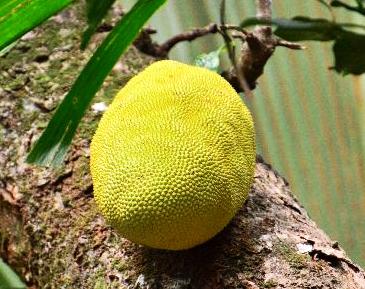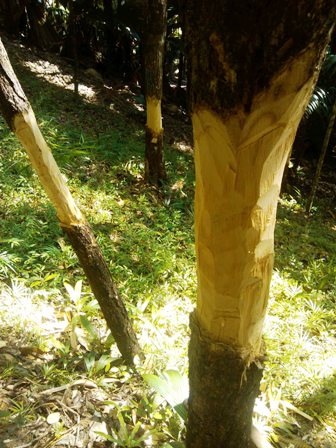Progress made on control of introduced trees in Vallée de Mai |15 September 2014

It is now four months since the Vallée de Mai invasive species team started the management of adult introduced trees. Since the last update, great progress has been made.
progress has been made.
Control of Albizia (Falcataria moluccana), Jackfruit (Artocarpus heterophyllus), Santol (Sandoricum koetjape), Chinese Fan Palm (Livistonia chinensis), Round-leaf Fountain Palm (Saribus rotundifolia) and Bwa Zonn (Alstonia macrophylla) has already been done.
Now two more crucial species have been added to the list ˗ Lagati (Adenathera pavonina) and Kalis Dipap (Tabebuia pallida).
Lagati and Kalis Dipap are among the most abundant invasive tree species in the Vallée de Mai. The survey carried out by the team earlier this year recorded 745 Lagati and 838 Kalis Dipap trees in the Vallée de Mai. But these high numbers did not prevent the team from successfully completing the ring-barking of 644 Lagati trees by the end of August. The rest of the trees have been left for felling or lopping due to their location near paths or roads.
Regarding the control of the Kalis Dipap, the team is in the process of ring-barking an impressive 20-30 trees per day, which equates to 100-200 hundred trees per week. Around 300 Kalis Dipap trees have been treated so far.
At the same time the team has been monitoring Lagati, Jackfruit and Bwa Zonn trees two months after their last control programme. The effects are more visible on Lagati, which shows the highest loss of leaves, mortality rate and unhealthy appearance. Many Jackfruit trees appear to be weakening but all Bwa Zonn remain healthy. Lagati’s healing responses are also the strongest, with 20% of the trees showing bark re-growth and/or re-sprouting. Mass fruiting has been observed in some of the treated Jackfruit trees, which will be closely monitored.
The team will continue to control Kalis Dipap and simultaneously check the effects of the control methods on all other species.




